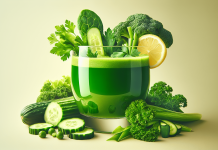In this article, we will be sharing a collection of delicious juice recipes that can help in managing diabetes and controlling blood sugar levels. These recipes are not only flavorful and refreshing but also packed with nutrients that are beneficial for those with diabetes. Whether you are looking to add variety to your daily juice routine or searching for natural ways to support your blood sugar management, these recipes are a great place to start. So, grab your juicer and let’s explore some amazing, diabetes-friendly juice recipes together!
Review contents
Understanding Diabetes and Blood Sugar Control
What is diabetes?
Diabetes is a chronic medical condition characterized by high blood sugar levels. It occurs when the body either cannot produce enough insulin or cannot effectively use the insulin it produces. Insulin is a hormone that regulates blood sugar levels and allows cells to use glucose for energy.
There are two main types of diabetes: type 1 and type 2. Type 1 diabetes is an autoimmune disease where the body’s immune system mistakenly attacks and destroys the insulin-producing cells in the pancreas. Type 2 diabetes, on the other hand, is more common and occurs when the body becomes resistant to insulin or doesn’t produce enough of it.
How does diabetes affect blood sugar levels?
In people with diabetes, blood sugar levels can become elevated and uncontrolled. This can lead to various health complications and symptoms, such as frequent urination, excessive thirst, fatigue, and slow wound healing. Over time, uncontrolled diabetes can also increase the risk of heart disease, kidney damage, nerve damage, and vision problems.
Blood sugar levels are influenced by factors such as diet, physical activity, medication, and insulin levels. For individuals with diabetes, it is particularly important to monitor and control blood sugar levels to maintain overall health and prevent complications.
The importance of blood sugar control
Maintaining good blood sugar control is crucial for individuals with diabetes. By keeping blood sugar levels within a target range, individuals can reduce the risk of serious complications and improve their overall quality of life. Blood sugar control is achieved through a combination of lifestyle changes, medication, and, in some cases, insulin therapy.
Proper blood sugar control not only helps manage diabetes but also plays a significant role in preventing and managing other health conditions, including heart disease and obesity. It allows individuals with diabetes to better manage their energy levels, maintain a healthy weight, and prevent spikes and crashes in blood sugar levels.
The Benefits of Juicing for Diabetes and Blood Sugar Control
Nutritional advantages of juicing
Juicing offers a convenient and efficient way to incorporate a variety of fruits and vegetables into one’s diet. By juicing fresh produce, individuals can obtain a concentrated source of essential vitamins, minerals, and antioxidants. These nutrients are vital for overall health and well-being, especially for individuals with diabetes.
Fruits and vegetables used in juicing are rich in fiber, which helps slow down the absorption of sugar into the bloodstream and prevents sudden spikes in blood sugar levels. Additionally, juicing can be a great way to increase the intake of nutrients and antioxidants that are beneficial for diabetes management.
How juicing can help regulate blood sugar levels
When done correctly, juicing can be a helpful tool in regulating blood sugar levels for individuals with diabetes. The process of juicing removes the insoluble fiber found in fruits and vegetables, making it easier for the body to absorb the nutrients and natural sugars.
By consuming freshly squeezed juices, the body can receive a quicker supply of nutrients, which can help regulate blood sugar levels more effectively. This can be particularly beneficial for individuals who struggle with digesting fiber-rich foods or have difficulty maintaining stable blood sugar levels.
Role of antioxidants in managing diabetes
Antioxidants play a crucial role in managing diabetes and blood sugar control. They help protect cells from damage caused by unstable molecules called free radicals, which are associated with various health conditions, including diabetes.
By incorporating antioxidant-rich fruits and vegetables into juicing recipes, individuals with diabetes can enhance their body’s ability to neutralize free radicals and reduce oxidative stress. This, in turn, can help improve insulin sensitivity, reduce inflammation, and promote overall better blood sugar management.
Choosing the Right Ingredients
Low glycemic fruits
When selecting fruits for juicing recipes aimed at managing diabetes and blood sugar control, it is important to choose low glycemic options. Low glycemic fruits have a minimal impact on blood sugar levels compared to high glycemic fruits.
Examples of low glycemic fruits suitable for juicing include berries, cherries, apples, pears, and citrus fruits like grapefruits and oranges. These fruits provide natural sweetness without causing sharp spikes in blood sugar levels.
Leafy greens and vegetables
Incorporating leafy greens and non-starchy vegetables into juicing recipes is highly beneficial for individuals with diabetes. Leafy greens such as kale, spinach, and Swiss chard are packed with essential vitamins, minerals, and fiber, without significantly impacting blood sugar levels.
Non-starchy vegetables like celery, cucumber, and broccoli also make excellent additions to juicing recipes. They provide valuable nutrients and fiber while contributing minimal carbohydrates and calories.
Spices and herbs for blood sugar control
Spices and herbs can add depth and flavor to juicing recipes while offering potential benefits for blood sugar control. Certain spices, such as cinnamon, turmeric, and ginger, have been shown to help regulate blood sugar levels and improve insulin sensitivity.
Including these spices in juicing recipes can provide not only a delicious taste but also an additional boost to blood sugar management efforts. However, it is essential to consult with a healthcare professional or nutritionist to ensure appropriate quantities and compatibility with any medications or existing health conditions.
The significance of fiber in juicing recipes
While juicing removes the insoluble fiber found in whole fruits and vegetables, it is still possible to incorporate soluble fiber into juicing recipes. This can be achieved by adding ingredients such as chia seeds, flaxseeds, or psyllium husk powder.
Soluble fiber helps slow down the digestion and absorption of sugar, resulting in a gradual increase in blood sugar levels. It also promotes a feeling of fullness and can aid in weight management, which is important for individuals with diabetes.
Juice Recipes for Diabetes and Blood Sugar Control
Green juice for blood sugar balance
Ingredients:
- 2 cups spinach
- 1 cucumber
- 2 stalks celery
- 1 green apple
- 1 lemon (peeled)
Instructions:
- Wash all the ingredients thoroughly.
- Cut the cucumber, celery, and apple into smaller pieces for easier juicing.
- Add all the ingredients to a juicer, starting with the leafy greens to ensure optimal extraction.
- Juice until smooth and well combined.
- Pour the green juice into a glass and serve immediately.
This refreshing green juice is rich in leafy greens and contains minimal sugar, making it suitable for maintaining blood sugar balance. The apple adds a touch of natural sweetness and complements the freshness of the other ingredients.
Beetroot and carrot juice to improve insulin sensitivity
Ingredients:
- 1 medium beetroot (peeled)
- 2 carrots
- 1-inch piece fresh ginger
- 1 lemon (peeled)
Instructions:
- Wash and peel the beetroot, carrots, ginger, and lemon.
- Chop the beetroot, carrots, and ginger into smaller pieces.
- Add all the ingredients to a juicer, ensuring the ginger is well incorporated.
- Juice until smooth and well combined.
- Pour the beetroot and carrot juice into a glass and serve immediately.
This vibrant juice combines the earthiness of beetroot, the sweetness of carrots, and the zing of ginger. Beetroot is known for its potential to improve insulin sensitivity, making this juice a great addition to a diabetes-friendly diet.
Citrus and ginger juice for inflammation and blood sugar spikes
Ingredients:
- 2 oranges (peeled)
- 1 grapefruit (peeled)
- 1-inch piece fresh ginger
- 1 teaspoon turmeric powder (optional)
Instructions:
- Peel the oranges, grapefruit, and ginger.
- Remove any seeds or pith from the citrus fruits.
- Chop the ginger into smaller pieces.
- Add all the ingredients to a juicer, ensuring thorough incorporation of ginger and optional turmeric powder.
- Juice until smooth and well combined.
- Pour the citrus and ginger juice into a glass and serve immediately.
This zesty juice combines the refreshing flavors of citrus fruits with the warmth of ginger. Citrus fruits are rich in vitamin C and antioxidants, which can help reduce inflammation and prevent blood sugar spikes.
Berry blast juice for improved glucose metabolism
Ingredients:
- 1 cup mixed berries (such as blueberries, raspberries, and strawberries)
- 1 green apple
- 2 stalks celery
- 1 lemon (peeled)
Instructions:
- Wash all the ingredients thoroughly.
- Cut the apple and celery into smaller pieces for easier juicing.
- Add all the ingredients to a juicer, starting with the berries for optimal extraction.
- Juice until smooth and well combined.
- Pour the berry blast juice into a glass and serve immediately.
This vibrant and delicious juice is packed with antioxidant-rich berries, which have been associated with improved glucose metabolism. The addition of apple and celery provides a subtle sweetness and extra nutrients.
Kale and cucumber juice for antioxidant support
Ingredients:
- 2 cups kale
- 1 cucumber
- 2 green apples
- 1 lemon (peeled)
Instructions:
- Wash all the ingredients thoroughly.
- Cut the cucumber and apples into smaller pieces for easier juicing.
- Add all the ingredients to a juicer, starting with the kale for optimal extraction.
- Juice until smooth and well combined.
- Pour the kale and cucumber juice into a glass and serve immediately.
This refreshing green juice combines the nutritional powerhouse of kale with the hydrating properties of cucumber. The addition of green apples and lemon adds a touch of sweetness and tanginess, making it a perfect balance of flavors.
Pineapple and turmeric juice for insulin resistance
Ingredients:
- 1 cup fresh pineapple chunks
- 1-inch piece fresh turmeric
- 1 green apple
- 1 lemon (peeled)
Instructions:
- Wash and peel the pineapple, turmeric, apple, and lemon.
- Chop the pineapple and apple into smaller chunks.
- Add all the ingredients to a juicer, ensuring thorough incorporation of turmeric.
- Juice until smooth and well combined.
- Pour the pineapple and turmeric juice into a glass and serve immediately.
This tropical juice blend combines the sweetness of pineapple with the powerful anti-inflammatory properties of turmeric. Pineapple contains bromelain, an enzyme that may help improve insulin sensitivity and reduce insulin resistance.
Carrot and bitter melon juice to manage blood sugar
Ingredients:
- 2 large carrots
- 1 small bitter melon
- 1 green apple
- 1 lemon (peeled)
Instructions:
- Wash all the ingredients thoroughly.
- Cut the carrots, bitter melon, and apple into smaller pieces for easier juicing.
- Add all the ingredients to a juicer, ensuring thorough incorporation of the bitter melon.
- Juice until smooth and well combined.
- Pour the carrot and bitter melon juice into a glass and serve immediately.
Bitter melon has been traditionally used in managing blood sugar levels. Combined with carrots and apple, this juice offers a balance of sweetness and the potential benefits of bitter melon in diabetes management.
Celery and lemon juice for detoxification and blood sugar control
Ingredients:
- 4 stalks celery
- 1 cucumber
- 1 lemon (peeled)
Instructions:
- Wash all the ingredients thoroughly.
- Cut the celery and cucumber into smaller pieces for easier juicing.
- Add all the ingredients to a juicer, starting with the celery for optimal extraction.
- Juice until smooth and well combined.
- Pour the celery and lemon juice into a glass and serve immediately.
This simple yet refreshing juice combines the hydrating properties of cucumber with the detoxifying benefits of celery. Lemon adds a tangy flavor and additional vitamin C.
Grapefruit and cinnamon juice for insulin regulation
Ingredients:
- 2 grapefruits (peeled)
- 1 teaspoon ground cinnamon
Instructions:
- Peel the grapefruits, ensuring all the pith is removed.
- Add the grapefruits and ground cinnamon to a juicer.
- Juice until smooth and well combined.
- Pour the grapefruit and cinnamon juice into a glass and serve immediately.
Grapefruit is a low glycemic fruit that can help regulate blood sugar levels. The addition of cinnamon further enhances its potential benefits by improving insulin sensitivity.
Spinach and apple juice for blood sugar stabilization
Ingredients:
- 2 cups spinach
- 2 green apples
- 1 cucumber
- 1 lemon (peeled)
Instructions:
- Wash all the ingredients thoroughly.
- Cut the apples and cucumber into smaller pieces for easier juicing.
- Add all the ingredients to a juicer, starting with the spinach for optimal extraction.
- Juice until smooth and well combined.
- Pour the spinach and apple juice into a glass and serve immediately.
This vibrant green juice combines the nutritional benefits of spinach with the natural sweetness of green apples. The addition of cucumber and lemon adds a refreshing twist and helps stabilize blood sugar levels.
Tips for Proper Juicing and Blood Sugar Management
Using fresh, organic produce
When juicing for diabetes and blood sugar control, it is important to use fresh, organic produce whenever possible. Fresh fruits and vegetables not only provide higher nutrient content but also minimize the exposure to pesticides and other chemicals that can disrupt insulin sensitivity and overall health.
Balancing fruit and vegetable ratios
While fruits are valuable sources of vitamins and antioxidants, they can be higher in natural sugars. It is essential to strike a balance between fruit and vegetable ratios in juicing recipes to avoid excessive sugar intake. This can be achieved by adding more vegetables or using low glycemic fruits as the base for juicing.
Avoiding added sugars and artificial sweeteners
To maintain blood sugar control and overall health, it is crucial to avoid using added sugars or artificial sweeteners in juicing recipes. Natural sweetness from fruits is sufficient to enhance the taste and nutritional value of the juice without contributing to blood sugar spikes.
Including protein and healthy fats in your diet
Incorporating sources of protein and healthy fats in your diet alongside juicing can help manage blood sugar levels more effectively. Protein and fats have minimal impact on blood sugar and can promote satiety, preventing sudden cravings or fluctuations in blood sugar levels.
Monitoring portion sizes and juice consumption
While juicing can be a valuable tool in managing blood sugar levels, it is important to monitor portion sizes and overall juice consumption. Drinking excessive amounts of juice, even if it contains primarily vegetables, can still result in significant sugar intake. Moderation is key to maintaining blood sugar control.
Consulting a healthcare professional or nutritionist
Before making significant changes to your diet or incorporating juicing into your diabetes management plan, it is important to consult with a healthcare professional or nutritionist. They can provide personalized guidance, ensure the compatibility of juicing with your medications and individual needs, and help monitor blood sugar levels effectively.
Precautions and Considerations
Effects of juicing on medication and insulin requirements
Juicing can have an impact on medication and insulin requirements, particularly for individuals with diabetes who are dependent on these treatments. Juicing may affect blood sugar levels, and adjustments to medication or insulin dosages may be necessary. It is crucial to work closely with a healthcare professional to monitor and adjust these requirements accordingly.
Individualized approach to juicing for diabetes
Every individual with diabetes has unique nutritional needs and health considerations. It is essential to take an individualized approach to juicing, considering factors such as personal preferences, blood sugar stability, and response to specific ingredients. Experimentation and monitoring of blood sugar levels are key to finding the right combination of ingredients and quantities.
Blood sugar monitoring and adjustments
Regular blood sugar monitoring is important when incorporating juicing into a diabetes management plan. Juice recipes may have varying effects on blood sugar levels, and it is crucial to observe and adjust accordingly. This will assist in understanding how juicing affects individual blood sugar control and enable appropriate modifications, if needed.
Possible side effects of certain juicing ingredients
Some individuals may experience gastrointestinal discomfort or allergic reactions to certain juicing ingredients. For example, some fruits and vegetables may cause bloating, gas, or digestive upset in sensitive individuals. It is important to pay attention to personal reactions and make necessary adjustments to ingredients or preparation methods.
Allergies and sensitivities to specific fruits or vegetables
Individuals with known allergies or sensitivities to specific fruits or vegetables should avoid those ingredients in their juicing recipes. Allergic reactions can range from mild to severe, and it is crucial to prioritize individual health and safety when selecting ingredients for juicing.
Conclusion
Juicing can be a beneficial addition to a diabetes management plan, offering a convenient way to incorporate nutritious fruits and vegetables into one’s diet. By selecting the right ingredients and following appropriate guidelines, individuals with diabetes can enjoy the nutritional advantages and potential blood sugar regulation benefits of juicing.
It is important to understand individual nutritional needs, monitor blood sugar levels closely, and seek professional guidance to ensure safety and optimize the use of juicing for diabetes management. Remember to consult with a healthcare professional or nutritionist to tailor juicing recipes to your specific needs and health considerations. With the right approach, juicing can be a valuable tool in supporting blood sugar control and overall well-being for individuals with diabetes.
































